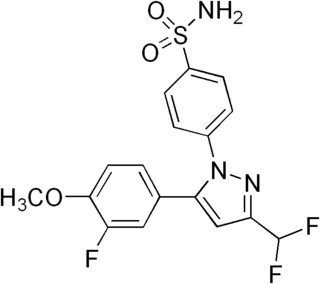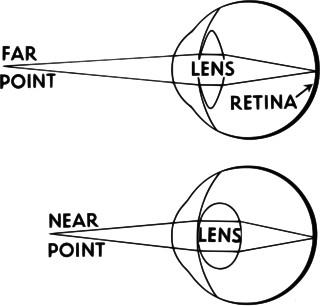
Chloramphenicol is an antibiotic useful for the treatment of a number of bacterial infections. This includes use as an eye ointment to treat conjunctivitis. By mouth or by injection into a vein, it is used to treat meningitis, plague, cholera, and typhoid fever. Its use by mouth or by injection is only recommended when safer antibiotics cannot be used. Monitoring both blood levels of the medication and blood cell levels every two days is recommended during treatment.

Carbamazepine, sold under the brand name Tegretol among others, is an anticonvulsant medication used in the treatment of epilepsy and neuropathic pain. It does not belong to the class of the benzodiazepines. It is used as an adjunctive treatment in schizophrenia along with other medications and as a second-line agent in bipolar disorder. Carbamazepine appears to work as well as phenytoin and valproate for focal and generalized seizures. It is not effective for absence or myoclonic seizures.

Chorioretinitis is an inflammation of the choroid and retina of the eye. It is a form of posterior uveitis. If only the choroid is inflamed, not the retina, the condition is termed choroiditis. The ophthalmologist's goal in treating these potentially blinding conditions is to eliminate the inflammation and minimize the potential risk of therapy to the patient.

Isotretinoin, also known as 13-cis-retinoic acid and sold under the brand name Accutane among others, is a medication primarily used to treat severe acne. It is also used to prevent certain skin cancers, and in the treatment of other cancers. It is used to treat harlequin-type ichthyosis, a usually lethal skin disease, and lamellar ichthyosis. It is a retinoid, meaning it is related to vitamin A, and is found in small quantities naturally in the body. Its isomer, tretinoin, is also an acne drug.

Cyclopentolate is a muscarinic antagonist. It is commonly used as an eye drop during pediatric eye examinations to dilate the eye (mydriatic) and prevent the eye from focusing/accommodating (cycloplegic). Cyclopentolate or atropine can also be administered to reverse muscarinic and central nervous system effects of indirect cholinomimetic (anti-AChase) administration.
Photophobia is a medical symptom of abnormal intolerance to visual perception of light. As a medical symptom photophobia is not a morbid fear or phobia, but an experience of discomfort or pain to the eyes due to light exposure or by presence of actual physical sensitivity of the eyes, though the term is sometimes additionally applied to abnormal or irrational fear of light such as heliophobia. The term photophobia comes from the Greek φῶς (phōs), meaning "light", and φόβος (phóbos), meaning "fear".

Pilocarpine is a medication used to reduce pressure inside the eye and treat dry mouth. As an eye drop it is used to manage angle closure glaucoma until surgery can be performed, ocular hypertension, primary open angle glaucoma, and to bring about constriction of the pupil following its dilation. However, due to its side effects it is no longer typically used for long-term management. Onset of effects with the drops is typically within an hour and lasts for up to a day. By mouth it is used for dry mouth as a result of Sjögren syndrome or radiation therapy.

Triamcinolone is a glucocorticoid used to treat certain skin diseases, allergies, and rheumatic disorders among others. It is also used to prevent worsening of asthma and COPD. It can be taken in various ways including by mouth, injection into a muscle, and inhalation.

Ketorolac, sold under the brand names Toradol, and Biorolac among others, is a nonsteroidal anti-inflammatory drug (NSAID) used to treat pain. Specifically it is recommended for moderate to severe pain. Recommended duration of treatment is less than six days. It is used by mouth, by nose, by injection into a vein or muscle, and as eye drops. Effects begin within an hour and last for up to eight hours.

Penicillamine, sold under the brand name of Cuprimine among others, is a medication primarily used for the treatment of Wilson's disease. It is also used for people with kidney stones who have high urine cystine levels, rheumatoid arthritis, and various heavy metal poisonings. It is taken by mouth.
Dorzolamide/timolol, sold under the brand name Cosopt among others, is a medication used to treat high pressure inside the eye including glaucoma. It is a combination of dorzolamide hydrochloride and timolol maleate. It may be used when a beta blocker, like timolol, is not sufficient alone. It is used as an eye drop.

Disopyramide is an antiarrhythmic medication used in the treatment of ventricular tachycardia. It is a sodium channel blocker and therefore classified as a Class 1a anti-arrhythmic agent. Disopyramide has a negative inotropic effect on the ventricular myocardium, significantly decreasing the contractility. Disopyramide also has an anticholinergic effect on the heart which accounts for many adverse side effects. Disopyramide is available in both oral and intravenous forms, and has a low degree of toxicity.
In pharmacology, biological activity or pharmacological activity describes the beneficial or adverse effects of a drug on living matter. When a drug is a complex chemical mixture, this activity is exerted by the substance's active ingredient or pharmacophore but can be modified by the other constituents. Among the various properties of chemical compounds, pharmacological/biological activity plays a crucial role since it suggests uses of the compounds in the medical applications. However, chemical compounds may show some adverse and toxic effects which may prevent their use in medical practice.
Enophthalmos is a posterior displacement of the eyeball within the orbit. It is due to either enlargement of the bony orbit and/or reduction of the orbital content, this in relation to each other.

Deracoxib is a nonsteroidal anti-inflammatory drug (NSAID) of the coxib class, used in dogs to treat pain associated with osteoarthritis, or to prevent pain following orthopedic or dental surgery. It is available as beef-flavored tablets.

Gingival enlargement is an increase in the size of the gingiva (gums). It is a common feature of gingival disease. Gingival enlargement can be caused by a number of factors, including inflammatory conditions and the side effects of certain medications. The treatment is based on the cause. A closely related term is epulis, denoting a localized tumor on the gingiva.

Ibopamine is a sympathomimetic drug, designed as a prodrug of epinine, used in ophthalmology. It induces mydriasis. It also has been investigated for use in the treatment of congestive heart failure.

Tofenacin is an antidepressant drug with a tricyclic-like structure which was developed and marketed in the United Kingdom and Italy in 1971 and 1981, respectively, by Brocades-Stheeman & Pharmacia. It acts as a serotonin-norepinephrine reuptake inhibitor, and based on its close relation to orphenadrine, may also possess anticholinergic and antihistamine properties. Tofenacin is also the major active metabolite of orphenadrine and likely plays a role in its beneficial effects against depressive symptoms seen in Parkinson's disease patients.
Comparison of the nonsteroidal antiandrogen (NSAA) bicalutamide with other antiandrogens reveals differences between the medications in terms of efficacy, tolerability, safety, and other parameters. Relative to the other first-generation NSAAs, flutamide and nilutamide, bicalutamide shows improved potency, efficacy, tolerability, and safety, and has largely replaced these medications in clinical practice. Compared to the second-generation NSAAs, enzalutamide and apalutamide, bicalutamide has inferior potency and efficacy but similar tolerability and safety and a lower propensity for drug interactions.

In ophthalmology, accommodative excess occurs when an individual uses more than normal accommodation for performing certain near work. Accommodative excess has traditionally been defined as accommodation that is persistently higher than expected for the patient's age. Modern definitions simply regard it as an inability to relax accommodation readily. Excessive accommodation is seen in association with excessive convergence also.














